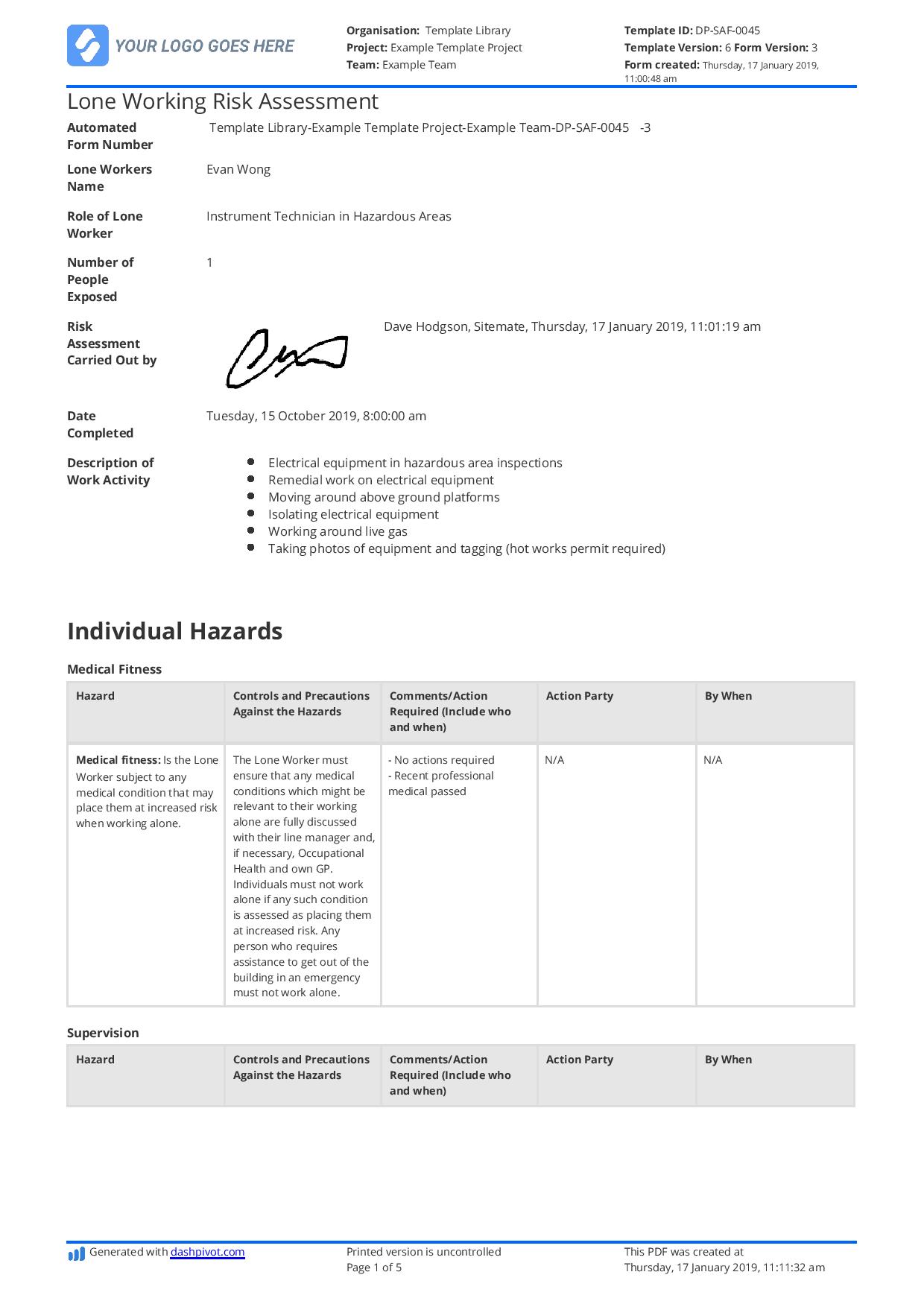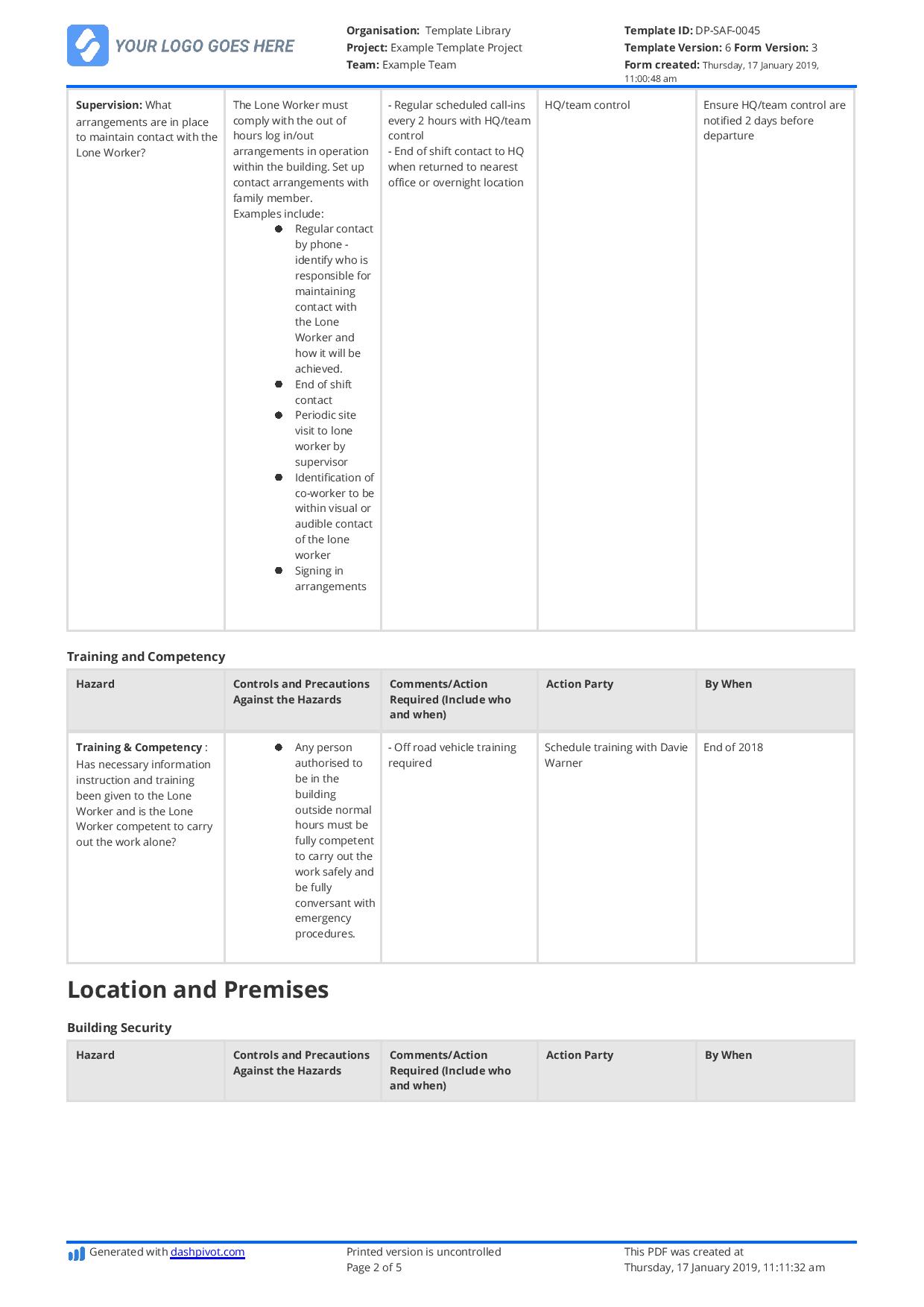Lone Working Risk Assessment Template
Start with a free 30-day trial. No credit card required.

~10,000 employees
~500 employees
~25,000 employees
~20 employees
~50 employees
~1,500 employees
~20 employees
What is a Lone Working Risk Assessment?
Lone working is one of the more common safety issues and hazards faced by many workers in industries like construction, oil and gas, mining. One of the ways workers and companies ensure they are prepared for lone working conditions is to conduct a lone working risk assessment. Like most risk assessments, this helps workers and other stakeholders brainstorm the potential dangers associated with that activity and then document the hazards, establish control measures and precautions against these hazards, create some required actions (where applicable), and establish who is responsible for these actions and when they need to be completed.
Compare this Lone Working Risk Assessment Form to manual Word, Excel, and PDF Formats
Use this Lone Working Risk Assessment template for free.
Why Use a Lone Working Risk Assessment?
A Lone Working Risk Assessment is an absolutely vital safety tool that should be used by anyone working without direct supervision or support. Here are the reasons why a lone working risk assessment is used:
Safeguards Workers
A Lone Working Risk Assessment identifies risks such as hazardous locations, or equipment issues and creates safeguards, including GPS tracking, check-ins, or even panic alarms.
Legal & Compliance Obligations
Many workplace safety rules require businesses to assess lone worker risks (e.g., OSHA, UK HSE, or AU WHS), and skipping it could lead to penalties or liability if anything goes wrong.
Plans for worst-case scenarios
What if a worker is threatened, trapped, or injured and he is or she is alone? A Lone Working Risk Assessment is not just a document, as it sets procedures that can save lives.
Boosts Output and Self-Confidence
Knowing their company supports them helps workers to feel safer, which reduces stress and improves focus, which can impact the company's profitability.
What Should be Included in a Lone Working Risk Assessment?
A Lone Working Risk Assessment is important for any worker without a direct supervisor or a coworker at arm's reach to guarantee safety and make sure everything is working smoothly. A good lone working assessment can have the following elements:
Worker’s Details
The first part of the lone working risk assessment details the lone worker’s name, the role he or she is performing in the workplace, the number of people exposed, the date completed, a description of the work activity done, and the supervisor or leader who carried out the assessment with a signature.
Individual Hazards
While every work scenario is unique, it is important to note the individual hazards involved, and the most common pertains to the medical fitness of the lone worker. The controls and precautions against the named hazards must also be put into writing, as well as the comments or actions to be done, the people or party to action, and by when it must be done. For every hazard found, such as supervision, training, and competency, it is vital to specify the things mentioned above to lessen the risks involved for the utmost safety of the lone worker.
Location and Premises
The location or premises where the lone worker works must also be documented to ensure there are no hazards found. Things prone to hazards include building security, access, emergencies, first aid, and facilities that must be checked with the controls, actions required, action party, and by when it must be actioned. They must also be documented and put forward in the lone working risk assessment to ensure there are no safety loopholes or problems that may arise in the future.
Process and Work Activity
Aside from the individual hazards and environment, the process or the activity the lone worker is facing might be prone to risks. If the lone worker is working onsite, slips, trips, and falls might happen, and the electrical equipment and machinery used may be a source of safety risks. Just like the individual and location risks, it is essential to put forward the controls and precautions, comments or actions, the party that needs to take action, and by when or the target date.
The list of elements in the lone working risk assessment can go on, depending on your company’s requirements, and always feel free to add or deduct more as needed. Also, don’t forget to add the review date every time to ensure it gets tracked and monitored on a timely basis.
Who Needs to use Lone Working Risk Assessments?
Any worker without direct supervision or immediate colleague support must conduct a lone working risk assessment. From remote workers to field service technicians, healthcare professionals to security staff, cleaners to delivery drivers, and real estate agents, lone workers can be found in many different sectors and job functions. Whether or not they are on-site, employers have a legal and moral obligation to guarantee their safety.
Remote or Isolated Employment: Those working in remote areas, such as construction sites, rural locations, or warehouses, may be at greater risk because of their limited access to assistance.
Staff working early mornings, late nights, or weekends may be more susceptible to accidents or security concerns.
Mobile Workers: Those who travel regularly, such as utility technicians, social workers, sales representatives, etc., require road or client site safety.
Jobs involving dangerous activities like machinery operation, electrical work, or confined spaces call for rigorous safety policies.
Workers at home or remotely: Those working from home could even run the risk of ergonomic injuries, mental health issues, or delays in emergency response.
Other popular templates you can use and customise for free

Job Hazard Analysis template
Easily complete a JHA on any device, and then keep all of your job hazard analyses neatly organised and searchable.

JSA template
This JSA template makes your JSA's easier to complete, share and keep organise so everyone performs their jobs more safely.

Meeting minutes template
Ensure the necessary steps are taken before handling hot works.
This Risk Assessment was generated with Dashpivot software
This lone working risk assessment template provides you with this reliable risk assessment framework. You can use the general hazards included in the template and edit and add new hazards for your specific jobs or company.
- Manage your lone working risk assessments online where they are automatically organised and always accessible.
Invite other people and team members to edit, sign and collaborate on risk assessments. - Download, print or send your risk assessments as professionally formatted CSV or PDF documents with your company logo and branding.
- Edit the template to suit your own projects and company with easy drag-and-drop functionality.
- Deploy the lone working risk assessment template to multiple lone workers so they all complete the same latest version of the document.
Sitemate builds best-in-class software tools for built world companies.



